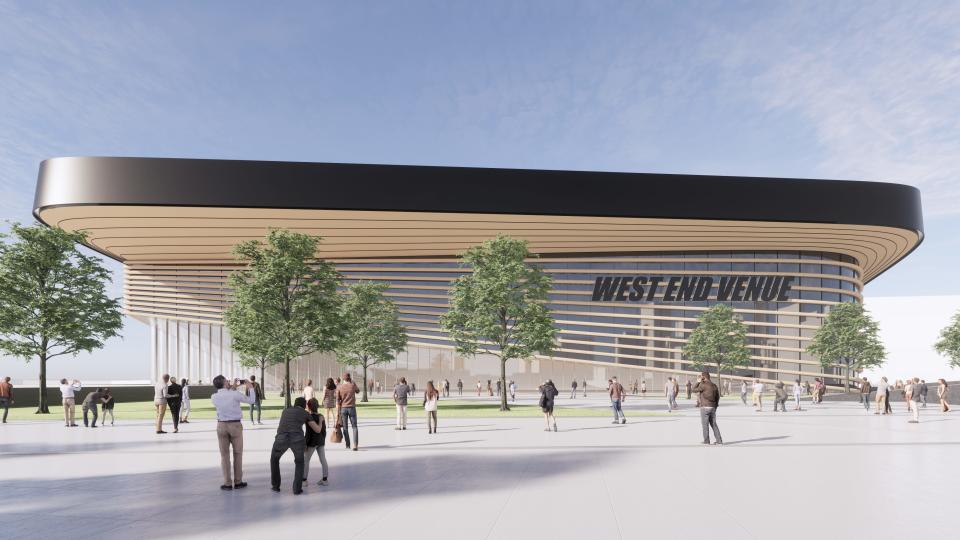Williams: Why timing on new arena, Norfolk Southern railroad sale pitches raise red flag

A public-relations campaign for a new Downtown arena has heated up amid insiders’ bull rush to sell a major city asset for more than $1 billion.
Coincidence? Maybe.
But Cincinnati voters have reason to be skeptical about an initiative on the Nov. 7 ballot calling for the sale of the publicly owned Cincinnati Southern Railway for $1.6 billion to Norfolk Southern.
Just what would the money really be used for if Issue 22 passes?
There’s no public outcry for a new arena, especially with no hope of landing a major anchor tenant and at a time when Bengals stadium improvements, a convention center overhaul and new Downtown hotel are much bigger entertainment/tourist-venue priorities.
Only insiders are pushing for an arena, and their package of flashy renderings and potential sites fed to the media recently was void of an all-important plan to pay for it.
There’s also no public outcry for the railroad sale. Only insiders are pushing for it, and city hall this week unveiled a last-minute, non-binding plan calling for the money to be used for infrastructure projects that the city should already be addressing in the annual budget.
Cincinnati Mayor Aftab Pureval has made himself the face of the Issue 22 campaign. Separate from the campaign, the Democrat has also said he supports building a new arena.
Insiders want everyone to think the arena idea and railroad sale proposal are two separate, unrelated deals. Technically, they are. Maybe with enough awareness and accountability from voters and taxpayers it’ll stay that way.
But having previously covered politics and business for this news organization, it makes me wary what the real intentions are for the railroad funds irrespective of Pureval’s gimmicky TV commercial telling voters the money would be used for roads, fire stations and parks.
I was around for then-Mayor Mark Mallory’s attempted money-grab to sell off the city’s parking meters, which was foiled. I was around for then-Mayor John Cranley’s failed parks-levy money grab. I covered the texting scandal and rampant public corruption at city hall.
The players at city hall are different now. But the same party responsible for most of the past problems still rules the place, and this mayor and council majority haven't done enough to rebuild the public’s trust in the institution. Sincere policy debates have been lacking on major issues, including on the railroad sale.
It was essentially an afterthought for city hall to put out a plan for how to use the railroad money if the ballot initiative passes. That plan was unveiled this past Monday, just more than a week before early voting starts Oct. 11.
Big red flag.
The plan includes basic infrastructure projects. Nothing about an arena, but perhaps that’s only because state Sen. Bill Blessing successfully pushed to keep the arena and other new pet-project ideas out of the state law that allowed the sale proposal to go forward.
Don’t be fooled, though. The language on what the money can and can't be used for is generally vague. State law can be changed later. And no change may be needed, after all. Politicians are good at moving money around.
Sure, the railroad money could ultimately go for the basic infrastructure projects outlined in the plan and promised in the commercial. But what about the money that’s already in the annual budget for those basic infrastructure projects? That money could be shifted to spend it on anything council wants, including a new arena.
Voters must be aware the railroad sale proposal was cooked up in private over several months by a city-appointed board. The railroad board settled a lawsuit over the privacy matter for $101,000 of taxpayer money, and council members never said a peep about it. If this is such a good deal – as the mayor says in his commercial − then why the secrecy?
Selling a debt-free, no-overhead public asset that delivers a guaranteed $25 million to the city’s coffers each year is a bad idea. That money will be there in perpetuity for generations of Cincinnatians yet to be born.
Always be skeptical when a politician stars in a campaign commercial pushing something that’s going to bring in a windfall of money to the government. (Remember when Cranley starred in those cheesy commercials for a parks levy?) This reeks of creating a slush fund for an ambitious politician to use to build a legacy project, which he can promote on a future campaign for higher office.
A new arena is a vanity project. It's not a need. It shouldn't be a priority, let alone loom as a possibility if the railroad sale is approved.
If Cincinnati had any chance of landing an NBA or NHL team as an anchor tenant for a new arena – you know, someone to pay the bills − then there'd be a legitimate argument to build the venue. None of those things are happening.
What the community really needs is some clarity and candor about how much the Bengals and taxpayers are going to pay to overhaul Paycor Stadium. City and business leaders could help Hamilton County officials with that.
We're waiting.
Contact columnist Jason Williams by email at jwilliams@enquirer.com and on Twitter @jwilliamscincy.
This article originally appeared on Cincinnati Enquirer: Timing on arena, Norfolk Southern railroad sale pitches raise red flag

